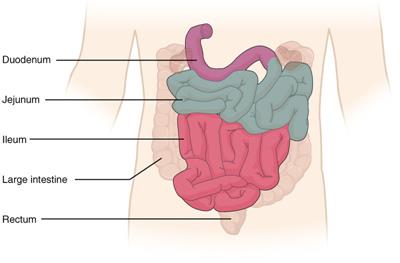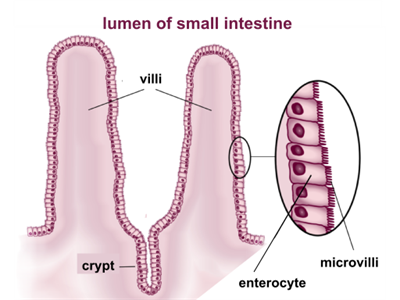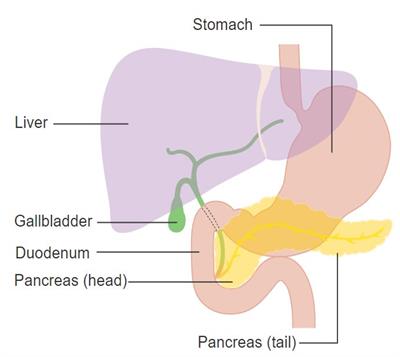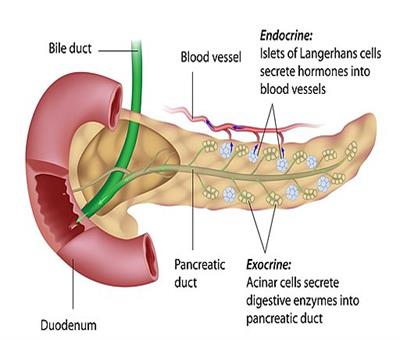PDF chapter test TRY NOW
Small intestine
The small intestine is a long coiled tube measuring about \(5-7\)m, and it is the longest part of the alimentary canal. Most of the digestion occurs in the small intestine. The small intestine is divided into three parts:
- Duodenum
- Jejunum
- Ileum
 |  |
Small intestine and microvilli
Duodenum:
It is the first part of the small intestine, a \(C\)-shaped structure that receives the bile duct from the liver and the pancreatic duct from the pancreas. After mixing with the stomach acid, the food moves into the duodenum and mixes with the liver's bile and digestive juices from the pancreas.
Jejunum:
It is the second part of the small intestine and, forms the middle region. It is a short region that secretes intestinal juice containing enzymes such as sucrase, maltase, lactase and lipase.
Ileum:
It is the structure that forms the lower part of the small intestine and opens into the large intestine. It is the longest part of the small intestine and contains minute finger-like projections called villi that are of \(1\)mmlong. Their villi are structures that increase the pace of absorption of food. They are approximately \(4\)million in number and \(1\)mm long. Internally each villus contains fine blood capillaries and lacteal tubes.
Both digestion and absorption take place in the small intestine. The duodenum receives bile from the liver and pancreatic juice from the pancreas. The intestinal glands secrete the intestinal juices.
Liver
It is the body's largest digestive gland and is reddish-brown. It is divided into two primary lobes, the right and left lobes, among which the right lobe is larger than the left lobe. The gall bladder is found under the surface of the liver. The bile juice secreted by the liver cells is temporarily deposited in the gall bladder and is released when the food reaches the small intestine.
The bile also contains bile pigments such as bilirubin and biliverdin; and bile salts such as sodium glycolate and sodium tauraglycolate. These salts aid in the digestion of fats by emulsifying the molecules (conversion of large fat droplets into small ones).
Functions of the liver:
- It controls the levels of blood sugar and amino acids.
- Produces red blood cells in the foetus.
- Blood clotting factors such as fibrinogen and prothrombin are produced.
- It is involved in the destruction of red blood cells.
- It is a storehouse of iron, copper, and vitamins such as \(A\) and \(D\).
- Anticoagulants such as heparin is produced here.
- It involved in the excretion of toxic and metallic poisons.
- Substances such as drugs and alcohol are detoxified in the liver.
- Transports nutrients from blood to the small intestine.
Pancreas
The pancreas is a lobed, leaf-shaped gland that is found between the stomach and duodenum. It is generally known as a heterocrine gland as it acts as both an exocrine and an endocrine gland.
- The exocrine portion of the pancreas secretes the pancreatic juice, which contains three enzymes - lipase, trypsin and amylase which act on fats, proteins and starch, respectively.
- The islets of Langerhans, which have endocrine cells and secrete hormones, are located on the gland's upper surface. (alpha) cells secrete glucagon, while (beta) cells secrete insulin.
 |  |
Bile duct and Pancreatic duct opening into duodenum
Reference:
https://commons.wikimedia.org/wiki/File:2417_Small_IntestineN.jpg
https://commons.wikimedia.org/wiki/File:Normal_pancreas_.jpg
https://upload.wikimedia.org/wikipedia/commons/4/4e/Diagram_showing_the_position_of_the_pancreas_CRUK_356.svg
https://upload.wikimedia.org/wikipedia/commons/thumb/0/0e/Villi_%26_microvilli_of_small_intestine.svg/512px-Villi_%26_microvilli_of_small_intestine.svg.png
